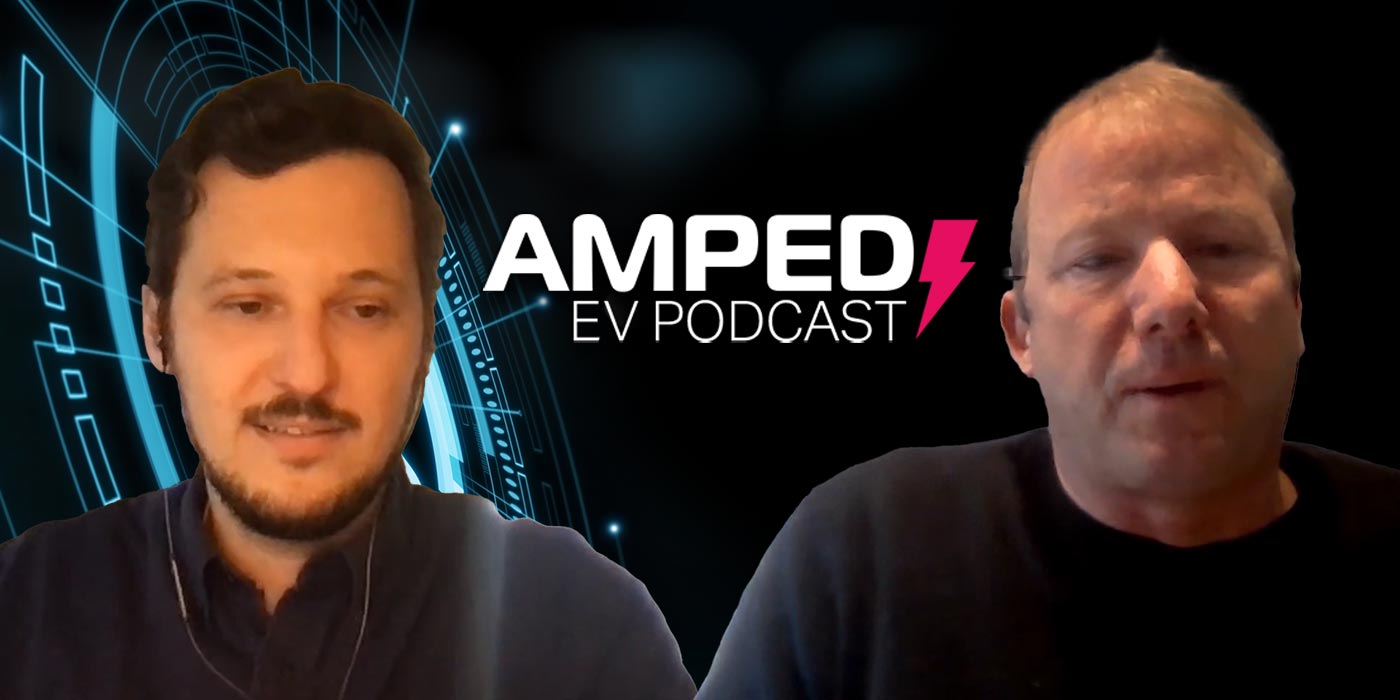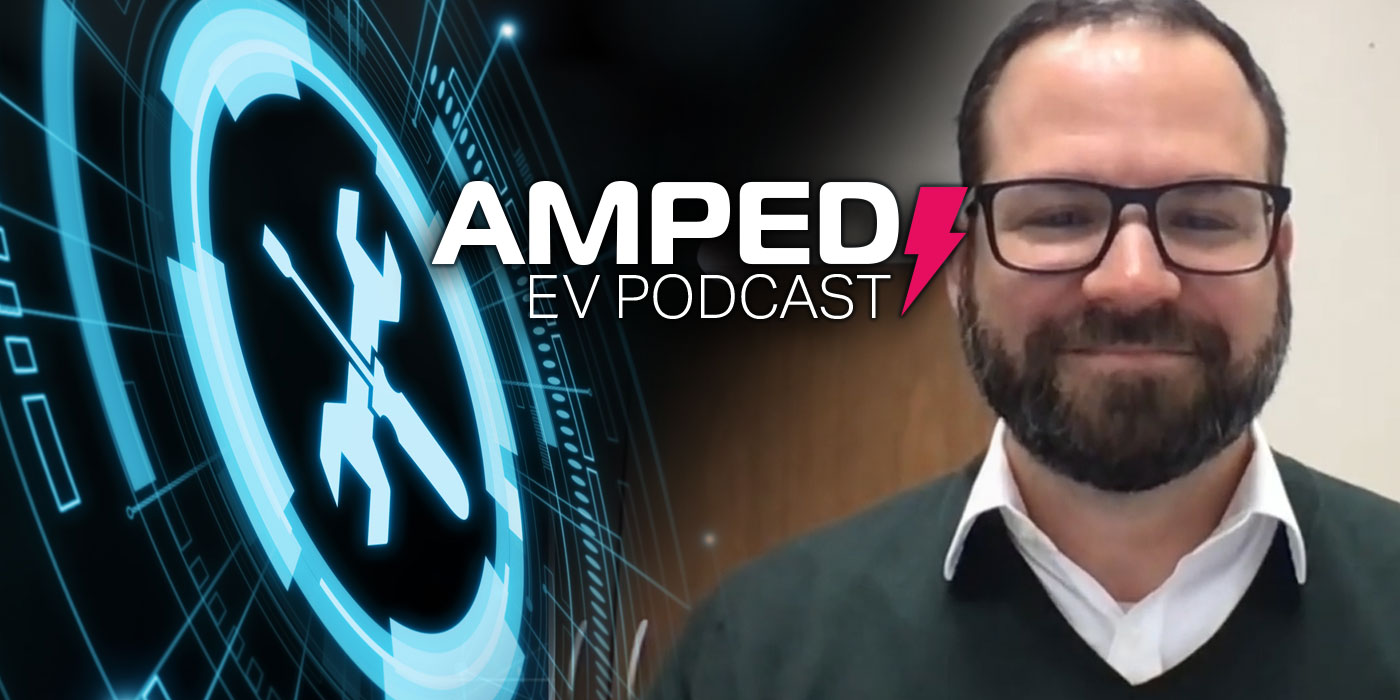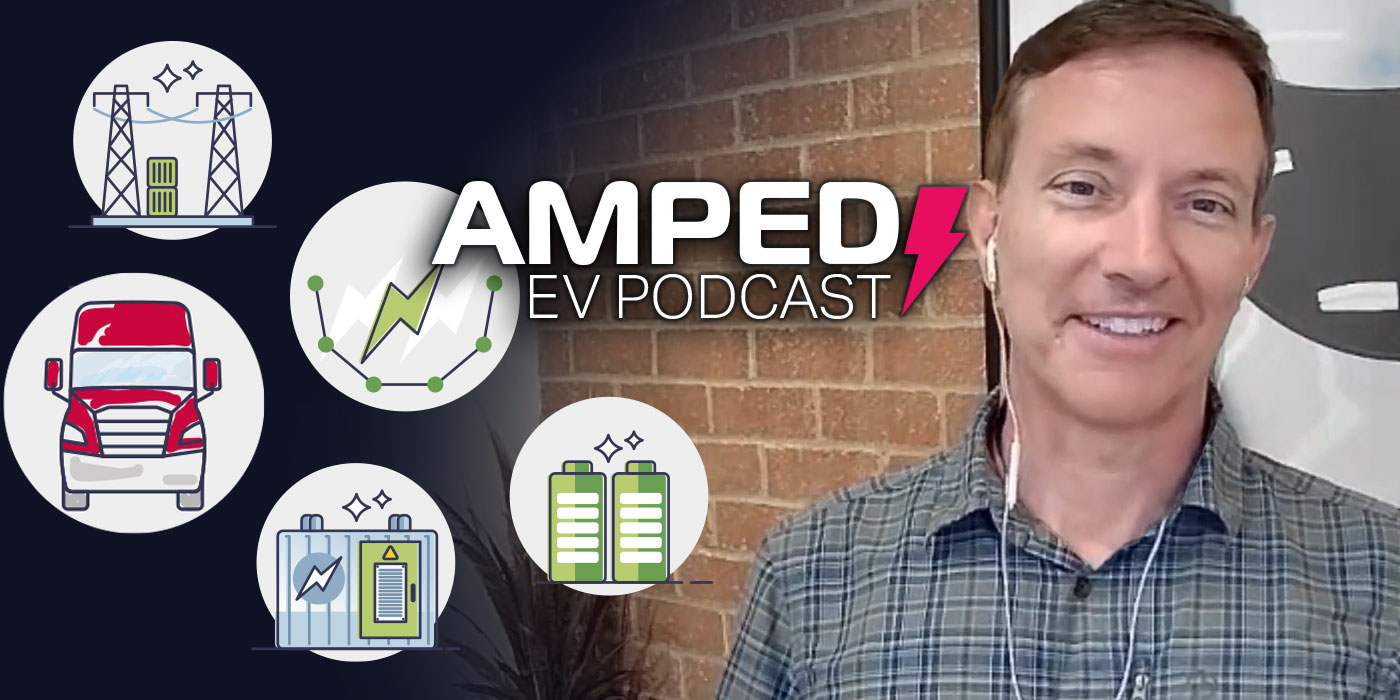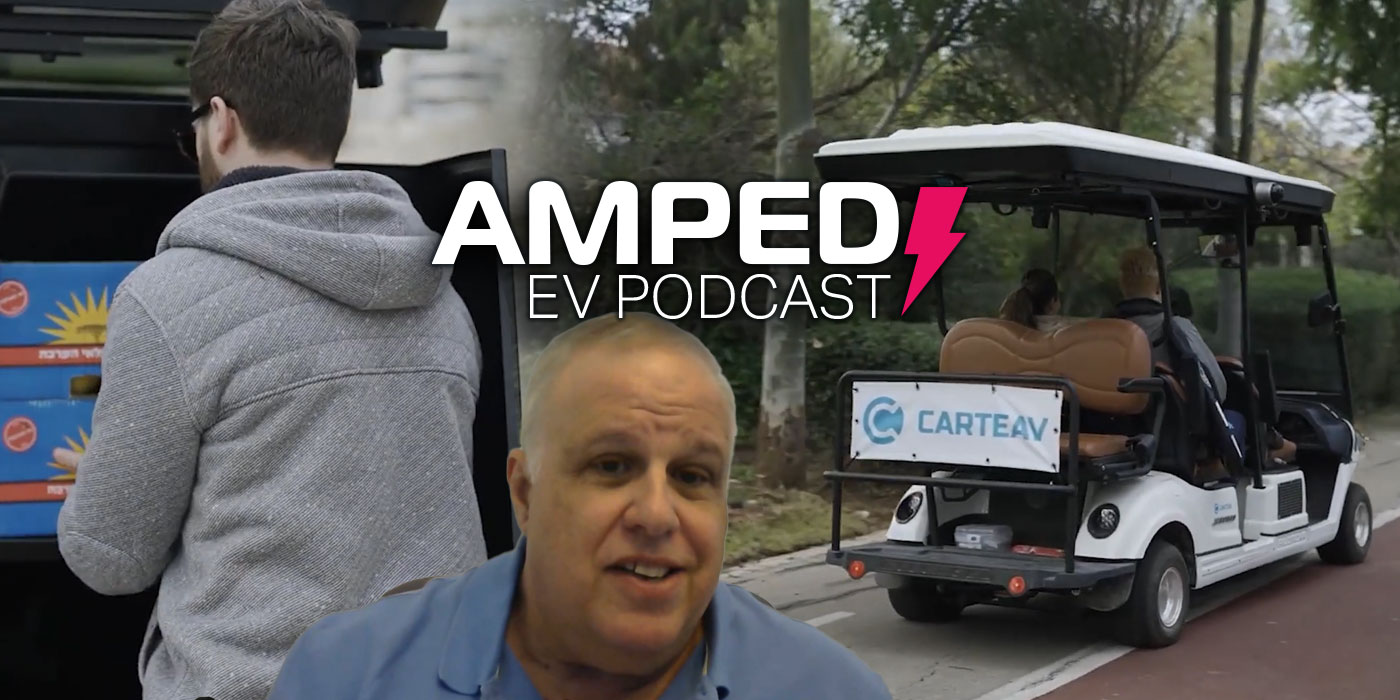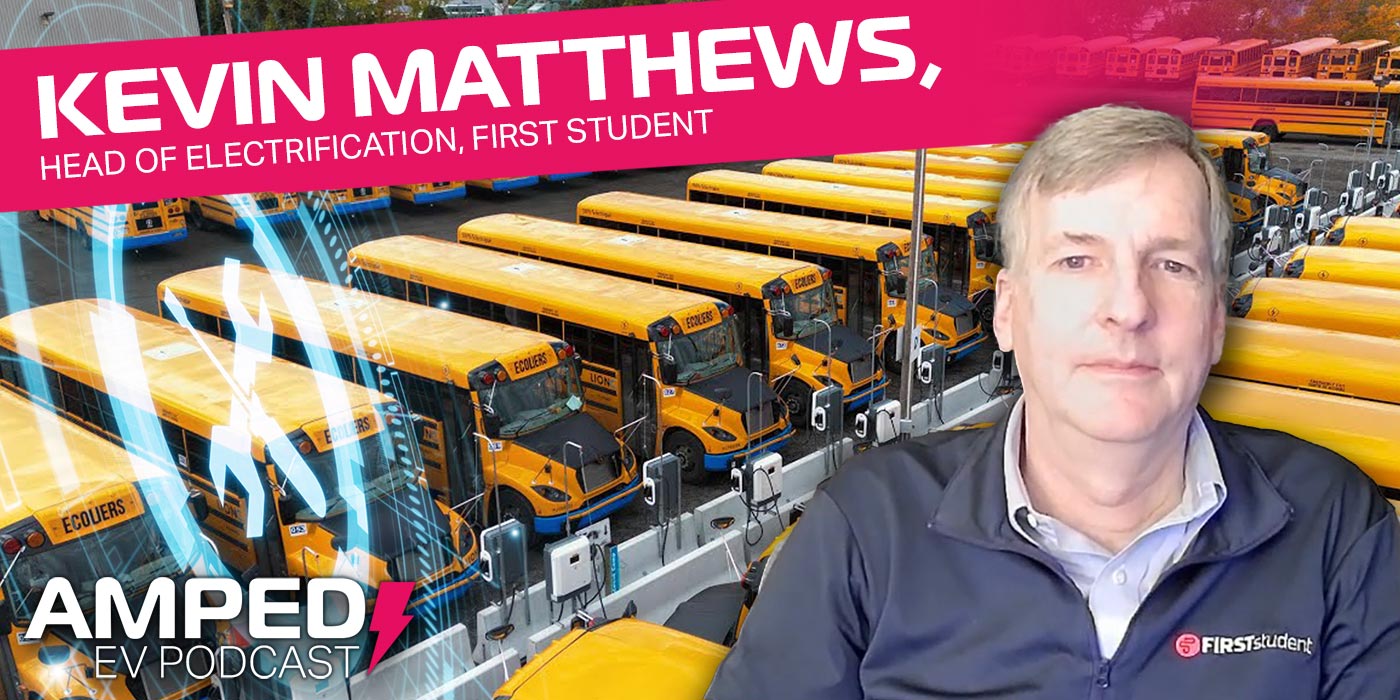It’s easy to read the headlines on social media and pontificate on where the market is headed in the comment sections of all your best friends’ posts. But if you really want to develop a solid understanding, it’s best to talk directly with those making waves in the industry. There’s no better place to do that than on the tradeshow floor.
Sustainability and electrification seem to be all the rage in the trucking industry today, but it isn’t always about swapping a diesel truck for an electric one. Instead, for America’s truck fleets it’s oftentimes more about a reduction in emissions and the journey to eventually hitting zero. Companies focusing on truck maintenance are approaching zero-emissions differently than OEMs designing new EV offerings, and telematics offerers have their own focus.
In this episode of The Amped EV Podcast, Fleet Equipment Editor Jason Morgan talks us through his electric truck market expectations based on what he’s seen at this year’s heavy- and medium-duty truck-centric tradeshows.
Want more Amped EV podcast? Click here.
Here’s a transcript of the show:
David Sickels: Hello and welcome back to The Amped EV Podcast. My name is David. I am the editor for The Buzz.
Jason Morgan: And I’m Jason Morgan, content director for Fleet Equipment. I’m back. Yeah. I’ve been locked outside the studio for like five months. I know you changed the locks. You changed the keypad.
David Sickels: We figured you’d done your time. It’s time to bring it back.
Jason Morgan: Yeah. You locked me… Well, I got the keys and now I’m back in the castle and I am amped. So we go. Feels good.
David Sickels: Honestly, people have been chanting your name, every episode that you’ve been gone, said, “Okay, we’ll give the people what they want.”
Jason Morgan: Well, I mean there’s a difference between enthusiasm and an angry mob. I mean, it’s a fine line. We did. They were just candy.
David Sickels: What kind of chant It was. So, we are having you in today to talk about electric trucks, because you just went to the Work Truck Show.
Jason Morgan: I went to every show there was every show in the past three months.
David Sickels: And the thing is, EVs tend to be something that comes up at just about every one of these shows.
Jason Morgan: It pops up.
David Sickels: It pops up.
Jason Morgan: It’s not like it starts every conversation.
David Sickels: But not that long ago, that wasn’t the case.
Jason Morgan: That’s true.
David Sickels: So tell me a little bit about Work Truck Show, what you saw there as far as EVs are concerned.
Jason Morgan: Yeah, yeah, sure. Well, can I take you on a journey? Picture a sea of equipment and you feel like every piece of equipment is electrified now because that’s what it felt like at Work Truck Show. So, let me work backward here. Work Truck Show was the last show I was at. I mean, I swear if there were six OEM press conferences the first day, everyone was battery loop, battery electric battery, battery, electric as Isuzu Mack, Hino. I mean, you name it, everyone was coming out. I did a walk around. Now Navistar had their EMV out for a while, but I got to walk around to that and saw the development there. So there was a lot going on.
What’s happening though is that like we’ve seen EVs come into the class seven eight space in the heavy-duty world that is coming into the work truck space. And when I say work truck space, that encompasses a lot of vocations really right now. I think they’re targeted in EVs in terms of pickup and delivery. So, box trucks right? or the UPS, brown-type trucks that you see running around the neighborhood, right? So those will be the first applications that those go into. And my question was always, well, why didn’t this happen first? Because the routes tend to be shorter. They tend to be stop-and-go. They tend to be back at base. And I think what it comes down to is finding the right options for people. And then in that work truck world, you have the manufacturer and then the upfitter right? and the upfitter, or body builder is someone that puts the body of the thing on the truck.
So, the truck is the cab and the frame rails, and then they put on the box or the drive-in, or they put on the, you know, the vacuum truck for a utility or a bucket truck for a utility or any other kind of truck you see running around. That’s a separate entity that does that. And so the OEMs and bodybuilders work very closely together to make sure there’s space on the frame rails for them to bolt their equipment to and the electric ball runs the way they want it to. And I mean, there’s a whole subset of truck spec’ing that is complicated enough without EVs that those partners work on. So I think it took a little bit of time to come to the work truck market just because they have to get those partners aligned. They put the batteries on the frame rails that’s, it’s in the room that body builders have to work with, right?
David Sickels: Yeah.
Jason Morgan: So that was Work Truck Show. Lots of excitement there. It feels a lot like the heavy-duty side. Maybe two years ago, a year-and-a-half ago when everybody was launching. And this is great.
On the flip side, the show before that was TMC. Now, this is more of a fleet management, maintenance-focused heavy-duty show, right? So, the attendance here are fleet managers and maintenance managers. The guys whose job is to keep the trucks running and fix the trucks and keep them going. It was quiet on EVs, very quiet. A lot of the conversation there was data and service and tires, which is very much in TMC’s wheelhouse. Last year was a little heavier on the EV side, I think because of the interest because the trucks were rolling into the market and they were really wondering.
David Sickels: I mean, there isn’t not a lot of them out there yet, right? So maintenance, we don’t know what we don’t know.
Jason Morgan: Right, and I think the takeaway from TMC was fleets want training. It’s kind of slow to come because the trucks, to your point, are slow to come out. And so if last year was the acceptance of EV and we’re going to move forward on this and we’re going to have to maintain them. This year was kind of a holding pattern for maintenance.
There were still calls for it but then also while we have a lot of other stuff we’re dealing with service, entire data kind of flooded in on the narrative and kind of took over there predictive maintenance as well. Take a step back, I went to Geotab Connect. So we’ve talked to Geotab’s Charlotte Argue on that side with their EV suitability assessment, right? Data. So the role of data on EVs, now that’s a user conference basically where Geotab had, they had it annually. And then the pandemic hit.
David Sickels: Geotab is on millions of vehicles out there.
Jason Morgan: Yes, 3.2 million vehicles. It’s one of the biggest vehicle telematics providers in the world. What was striking was the number of EVs on their show floor. So a lot of the time the data and technology user conferences, lots of booths, but not a ton of equipment because it’s a data solutions data. But there was a ton of equipment here, lots of EVs from vans to larger kind of those work truck size class one through three EVs. And their whole thing is that in addition to the EV suitability assessment where they have the tool that tells you if you’re ready to go.
All the data that kind of bakes into this sustainability drive, right? They’re looking at like, look, yes, there are EVs, but it’s a larger part of decarbonization. And then move towards sustainability. In talking with Geotab on the sustainability side, it’s this idea that they can take all your data and break it into manageable chunks of what technology is available today, what you can do today reasonably and make money with, and then what your journey will look like. So it’s not so much EVs a hundred percent, go for it. Look at your debt and your operations. Let’s look at the solutions that are available and viable in the market, and then let’s map out your journey, which honestly as we talk more about, this is a little bit more of an easier pill to swallow, right? It’s not as exciting to talk about, but it’s a realistic view of how we move there.
David Sickels: And you know, the commercial side is, it’s so much different than the consumer side where you know as a consumer, it’s much easier for me compared to just say, Hey, I’m all in on EVs. I’m going to go buy myself an electric-powered car and now I’m more sustainable and all that. If you are on the commercial side and you’re running a fleet, that’s a whole nother story. I mean, you’re talking about installing crazy amounts of infrastructure potentially and converting this fleet of diesel-powered trucks and you’ve invested thousands and thousands of dollars in.
Jason Morgan: True.
David Sickels: Into this whole new thing. And you’re worried about all these different maintenance parts and pieces and things. So when you’re talking the commercial side, I can see how Geotab is focusing more on, Hey, we’re looking more at sustainability. It doesn’t have to be we’re all electric-powered now, let’s go there. It is hey, what can you do to make your fleet more sustainable? Because there are these kinds of rules coming down from state governments or federal governments that are saying, Hey, these fleets, you need to increase your sustainability if you want to keep rolling.
Jason Morgan: Right, right. I like how you say that on the consumer side, because I don’t know if you’ve seen new car prices, but the pay grade for the host of this show must be really different from pay grade of the co-host. And so I think you showed your cards there a little, Mr. Sickles.
David Sickels: Fair enough. Fair enough.
Jason Morgan: Going back to it, yeah, Geotab wants to be integrated with OEM data. They want to use fleet data and they want to figure out solutions. And then real quickly, the first show, the last I’ll talk about the first show of the year I was at, which you wouldn’t expect maybe a ton of EV chatter was HDAW. So this is heavy-duty aftermarket week. So this is the entire heavy-duty aftermarket coming together and lots of electrification buzz there.
Still, I mean in terms of parts and solutions lying behind, infrastructure and charging equipment I think is coming up big there in that segment. But one fun little wrinkle narrative that is coming out is the idea of the sustainability impact of using remanufactured parts versus new parts.
How that impacts carbon footprint waste. So again, it just goes to show the entire industry from every aspect, from aftermarket to maintenance, to new trucks to work trucks, all trying to figure out the sustainability piece, what it means. Everyone knows we have to get to a certain point relatively quickly in 2014 and 2050. So now you’re really starting to see the market, trying to figure out what that means.
David Sickels: Interesting. Okay. Do you have any thoughts on Cummins? Cummins introduced a new brand, Accelera, which is more focused on the zero emissions side of things. But when you think Cummins, you think of diesel engines. So what is the story here? Why are they investing so much? Why are they creating this new brand for zero-emissions?
Jason Morgan: Right. So yeah, my take on this will not be as hot as maybe what maybe people might think it is. I think you hit on the head. It’s a new brand. So look, hydrogen fuel cells, battery, electric, E axles, traction systems, electrolyzers, all things Cummins has been doing, they call it new power. That was their new power business, now it’s called Accelera.
David Sickels: And we saw a little wrinkle of this last year at ACT Expo, I believe, with their kind of hybrid hydrogen diesel engine. Is that right?
Jason Morgan: Yeah, Well, and I think so again, I don’t know the details and I haven’t talked to Cummins yet. I’ve something scheduled for them later here in the coming months. But it seems to me that the ice will still stay with Cummins. So whether that’s natural gas or hydrogen or gasoline even, or diesel, that is still Cummins, the Accelera, again. Now, this is just my own personal take. This is, I have no actual information on this. I’m just like you all looking at it from the outside end, but yeah, it does. It’s interesting that they differentiate it from that Cummins name if they might fee. And again, Cummins is very strong in terms of the diesel industry, right? Yes. So do you need another brand that kind of speaks toward maybe some of how quickly the market’s moving, right? Yeah. Accelera is kind of fun in terms of it is moving fast. People do need solutions.
How you balance that from a huge brand with tons of brand equity there all in combustion engines versus a lot of the new power stuff and it’s all zero emissions, right? So this is their move to bring, it’s not Cummins new power, it’s now Accelera.
And so, it just kind of gives a little freshness. It’s things that they have been working on for years. I talked to them last May or June about all of this. So to your point, new branding, bringing it under one umbrella and not so that at least to me, it’s like, no, these are products we’re bringing in the market and we’re going to bring it under this brand and help you kind of accelerate that transition.
David Sickels: I mean, personally, I really like the name, but also I think the new branding, it kind of shows that, hey, we’re putting a lot of work into this. We’ve got teams that are dedicated to this part of our business as opposed to if they kept it under the Cummins name, maybe, I don’t know. From the outside looking in, you might think people are kind of splitting their time here.
Jason Morgan: Yeah.
David Sickels: It’s good to have its own separate entity for what’s going on.
Jason Morgan: Right, right now there are a hundred, I’d caught up with them at the shows. They are 100% dedicated to zero emissions. They call it destination zero, right? They’re a hundred percent committed to that. This is a big way for what they’re doing and that branding indicates that as well. But stepping back though too, and Geotab’s point of view and the decarbonization point of view, and I think what we’re seeing too, one of the other big trends is that the path aware which we get there. So again, going back seven and eight, lots of big excitement. But again, I personally feel like we’ve come up and we’ve kind of hit a plateau there.
And in some anecdotal stuff, infrastructure is really difficult right now. So you have the first wave of class, seven, eight adopters who have adopted the trucks, they put the infrastructure in.
You got that larger wave right behind them that has interest, right? And the equipment’s available. It’s evolving, but the infrastructure is just such a challenge. It’s so specific to your area, your state, and your utility that there’s no magic bullet there. And so that’s kind of plateaued, I think what we’re seeing in work truck now, in that class one through six markets, that first initial wave coming up, right? Where you have all those trucks that are going to become available in 24.
And that’s all exciting. We’ll see how they do in terms of what they can do in infrastructure. Do they kind of hit the same plateau? Does it breakthrough? Because they’re a of couple years behind on where Class 7, 8 is pushing. You got regulation coming in in California that says you’re, you’re going to have to buy a zero-emission vehicle to some degree. So there are a lot of things in the works there. Really the sticking point right now is that infrastructure piece, and it’s just going to take time and work and effort, advocacy education, it’s kind of a thing.
David Sickels: It’s a lot to deal with.
Jason Morgan: I know.
David Sickels: One last point I wanted to talk about with you, ACT Research came out with a report in mid-March saying that they expect 2023 EVs are going to triple production as compared to 2022. Now that sounds like EVs for everyone. What does that really mean?
Jason Morgan: That’s a fun headline. What they also said that it accounts for less than 1% of total truck production. Now if you look at 2022 overall truck production, it was 309,615 vehicles.
David Sickels: Vehicles. Not just EVs.
Jason Morgan: All in. Commercial vehicles. 309,615.
David Sickels: So we’re talking 1% of that.
Jason Morgan: 1% And that’s easy math because you just move decimal points. I didn’t know that though. I didn’t use a percentage calculator because I’m an editor and I don’t understand numbers, but I did double-check it. Right? So really if you take just 1% of that is 3,096 trucks.
David Sickels: So triple that, we’re just under 10,000?
Jason Morgan: Well, less than 1%.
David Sickels: Less than 1%. Okay.
Jason Morgan: So yeah, if that triple will count for less than the 3000, there’s still a long ways to go. Now again, that’s not. I know that’s kind of a harsh reality to put it in, but it’s again going back to the idea of, okay, well where do we get to where we need to be, where we need to be in 2040? I mean, you look at 2040 where a number of the truck OEMs have said they’re going to have a all zero emission lineup by then. You look at 2050, which is just kind of the end of day’s deadline that scientists have set up. Okay, so how do we get to that? Right? Let’s take the inconsideration that, hey, production will triple, that’s a real number. It’s still a small majority of truck or a small minority of trucks because of course it is, because it’s not meeting all the applications.
But we’re seeing, and that’s 23, these work trucks we were talking about earlier, 24. Right? So what does that mean when those come into the market? And look, I’m still, again, this is my own personal take on the class eight side. We’re going to need something else for long haul. You’re going to need hydrogen fuel cell, at this point, the way it’s looking. Yeah, we’re going to need something else. And those are the trucks on the highways that are moving tons of goods. I mean, there is, you know off the top of my head of the past, the last four months, the last year, more than a hundred thousand of those ordered in the last quarter, last four months going into this year, there’s a lot of Class A trucks for that. Yes. That will be. So all these segments, once all these segments align with zero emission solutions, that’s when we’ll start to see a larger tipping point in terms of sustainability.
David Sickels: I do wonder if it triples this year, is it going to triple the next year? Are we looking at a hockey stick here kind of graph? You know?
Jason Morgan: Well, again, if it fits the application and the numbers work, then great infrastructure again, that’s got to get figured out. But there’s a lot of money being pumped into that in terms of what the government’s doing on the in Inflation Reduction Act. And then even what you look at what Daimler Trucks is doing with some of their partnerships. You look at Volvo trucks, they’re partnering with truck stops to put EV charging in as well. So we’re getting there. We’re getting, again, I hockey stick, maybe slow. I don’t know. Always nothing good happens quickly. Right. So that’s my take. I think the market’s going there. I think that a big takeaway for me is I’ll have Ashley pull out that it’s happening, chip again, because it is happening. The reality is like, okay, how are we going to get there? Right? You want to go on vacation with your family? You want to get to the beach, the highway’s closed.
David Sickels: Absolutely. Sounds good. Thank you very much for the insight. It’s always interesting to see where the consumer side is going and where the commercial side is going and where they’re kind of meeting up in the middle there. So I really appreciate you coming back.
Jason Morgan: Yeah, thanks for having me. This was fantastic.
David Sickels: Thanks again. Thank you. Thank you all for joining us. We’ll see you next time.






